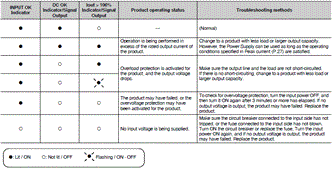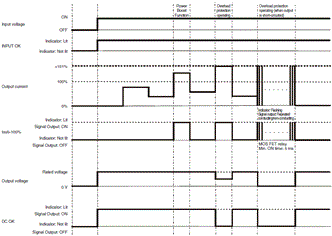S8VK-WB
Switch Mode Power Supply (240/480/960-W Models)
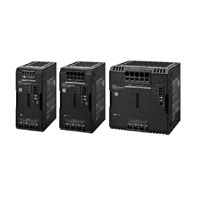
Even more compact three-phase 380 to 480 V input power supplies. Reduces wiring work with the Push-In Plus terminals. With a line-up that includes 24 VDC and 48 VDC models.
- Features
- Lineup
- Specifications
- Dimensions
- Catalog / Manual / CAD / Software
last update: December 1, 2023
Ratings, Characteristics, and Functions
| Power rating | 240W | 480W | 960W | ||
|---|---|---|---|---|---|
| Output voltage | 24V | 24V | 24V | ||
| Efficiency *1 | Three-phase 400 VAC input | 93% typ. | 94% typ. | 95% typ. | |
| Two-phase 400 VAC input | 93% typ. | 94% typ. | 95% typ. | ||
| Input
conditions |
Input voltage range *2 | Three-phase/two-phase 320 to 576 VAC, 450 to 810
VDC |
|||
| Frequency *2 | 50/60 Hz (47 to 63 Hz) | ||||
| Input current *1 | Three-phase 400 VAC input | 0.41 A typ. | 0.79 A typ. | 1.6 A typ. | |
| Two-phase 400 VAC input | 0.75 A typ. | 1.5 A typ. | 3.0 A typ. | ||
| Power factor *1 | Three-phase 400 VAC input | 0.9 min. | |||
| Leakage current
*3 |
Three-phase 400 VAC input | 3.5 mA max. | |||
| Inrush current *4 | Three-phase 400 VAC input | 1.9 A typ. | 3.3 A typ. | 10.6 A typ. | |
| Output
character- istics |
Rated output current | 10 A | 20 A | 40 A | |
| Power Boost Function | 15 A | 30 A | 60 A | ||
| Voltage adjustment range *5 | 24 to 29.5 V (with V.ADJ) | 24 to 28 V
(with V.ADJ) |
|||
| Ripple noise
voltage *6 |
Three-phase
380 to 480 VAC input |
100 mV p-p max.
at 20 MHz of bandwidth |
80 mV p-p max.
at 20 MHz of bandwidth |
50 mV p-p max.
at 20 MHz of bandwidth |
|
| Input variation influence *7 | 0.5% max. | ||||
| Load variation influence *8 | 1.5% max. | ||||
| Temperature
variation influence |
200 to 240 VAC input | 0.05%/°C max. | |||
| Startup time *9 | Three-phase 400 VAC input | 1,000 ms max. | |||
| Output hold time
*9 |
Three-phase 400 VAC input | 30 ms typ. | 25 ms typ. | 20 ms typ. | |
| Additional
functions |
Overload protection | Yes, automatic reset, intermittent operation type Refer
to Overload Protection on below. |
|||
| Overvoltage protection | Yes, 130% or higher of rated output voltage, power
shut off (shut off the input voltage and turn on the input again), Refer to Overvoltage Protection on below. |
||||
| Series operation | Yes (For up to two Power Supplies; external diodes
required.) |
||||
| Parallel operation | Yes (For up to two Power Supplies), Refer to Parallel
Operation on Data Sheet. |
||||
| INPUT OK Indicator | Yes (LED: Green) | ||||
| DC OK Indicator | Yes (LED: Green) | ||||
| Iout > 100% Indicator | Yes (LED: Yellow) | ||||
| DC OK Signal Output | Yes (MOS FET relay output 30 VDC max., 50 mA max.) | ||||
| Iout > 100% signal output | Yes (MOS FET relay output 30 VDC max., 50 mA max.) | ||||
| Insulation | Withstand voltage | 3.0 kVAC for 1 min. (between all input terminals and
all output terminals, signal output terminals), cutoff current 20 mA |
|||
| 2.5 kVAC for 1 min. (between all input terminals and
PE terminals), cutoff current 30 mA |
|||||
| 1.0 kVAC for 1 min. (between all output terminals,
signal output terminals and PE terminals), cutoff current 25 mA |
|||||
| 0.5 kVAC for 1 min. (between all output terminals and
all signal output terminals), cutoff current 10 mA |
|||||
| Insulation resistance | 100 MΩ min. (between all output terminals, signal
output terminals and all input terminals / PE terminals) at 500 VDC |
||||
| Environ-
ment |
Ambient operating temperature *10 | -40 to 70°C (Derating is required according to the
temperature. Refer to Engineering Data on Data Sheet.) (with no condensation or icing) |
|||
| Storage temperature | -40 to 85°C (with no condensation or icing) | ||||
| Ambient operating humidity | 95% max. (Storage humidity: 95% max.) | ||||
| Vibration resistance *11 | 10 to 55 Hz, maximum 5 G, 0.42 mm single amplitude
for 2 h each in X, Y, and Z directions |
||||
| Shock resistance *11 | 294 m/s2, 3 times each in ±X, ±Y, ±Z directions | ||||
| Reliability | MTBF *12 | 170,000 hrs typ. | 160,000 hrs typ. | 140,000 hrs typ. | |
| Expected life *13 | 10 years min. | ||||
| Construc-
tion |
Weight | 890 g max. | 1,200 g max. | 1,800 g max. | |
| Cooling fan | No | ||||
| Degree of protection | IP20 by EN/IEC 60529 | ||||
| Power rating | 240W | 480W | 960W | ||
|---|---|---|---|---|---|
| Output voltage | 48V | 48V | 48V | ||
| Efficiency *1 | Three-phase 400 VAC input | 93% typ. | 94% typ. | 96% typ. | |
| Two-phase 400 VAC input | 93% typ. | 94% typ. | 95% typ. | ||
| Input
conditions |
Input voltage range *2 | Three-phase/two-phase 320 to 576 VAC, 450 to 810
VDC |
|||
| Frequency *2 | 50/60 Hz (47 to 63 Hz) | ||||
| Input current *1 | Three-phase 400 VAC input | 0.41 A typ. | 0.78 A typ. | 1.6 A typ. | |
| Two-phase 400 VAC input | 0.75 A typ. | 1.5 A typ. | 2.9 A typ. | ||
| Power factor *1 | Three-phase 400 VAC input | 0.9 min. | |||
| Leakage current
*3 |
Three-phase 400 VAC input | 3.5 mA max. | |||
| Inrush current *4 | Three-phase 400 VAC input | 1.7 A typ. | 3.0 A typ. | 10.5 A typ. | |
| Output
character- istics |
Rated output current | 5 A | 10 A | 20 A | |
| Power Boost Function | 7.5 A | 15 A | 30 A | ||
| Voltage adjustment range *5 | 48 to 56 V (with V.ADJ) | ||||
| Ripple noise
voltage *6 |
Three-phase
380 to 480 VAC input |
50 m V p-p max.
at 20 MHz of bandwidth |
60 mV p-p max.
at 20 MHz of bandwidth |
60 mV p-p max.
at 20 MHz of bandwidth |
|
| Input variation influence *7 | 0.5% max. | ||||
| Load variation influence *8 | 1.5% max. | ||||
| Temperature
variation influence |
380 to 480 VAC input | 0.05%/°C max. | |||
| Startup time *9 | Three-phase 400 VAC input | 1,000 ms max. | |||
| Output hold time
*9 |
Three-phase 400 VAC input | 30 ms typ. | 25 ms typ. | 20 ms typ. | |
| Additional
functions |
Overload protection | Yes, automatic reset, intermittent operation type Refer
to Overload Protection on below. |
|||
| Overvoltage protection | Yes, 130% or higher of rated output voltage, power
shut off (shut off the input voltage and turn on the input again), Refer to Overvoltage Protection on below. |
||||
| Series operation | Yes (For up to two Power Supplies; external diodes
required.) |
||||
| Parallel operation | Yes (For up to two Power Supplies), Refer to Parallel
Operation on Data Sheet. |
||||
| INPUT OK Indicator | Yes (LED: Green) | ||||
| DC OK Indicator | Yes (LED: Green) | ||||
| Iout > 100% Indicator | Yes (LED: Yellow) | ||||
| DC OK Signal Output | Yes (MOS FET relay output 30 VDC max., 50 mA max.) | ||||
| Iout > 100% signal output | Yes (MOS FET relay output 30 VDC max., 50 mA max.) | ||||
| Insulation | Withstand voltage | 3.0 kVAC for 1 min. (between all input terminals and
all output terminals, signal output terminals), cutoff current 20 mA |
|||
| 2.5 kVAC for 1 min. (between all input terminals and
PE terminals), cutoff current 20 mA |
|||||
| 1.0 kVAC for 1 min. (between all output terminals,
signal output terminals and PE terminals), cutoff current 30 mA |
|||||
| 0.5 kVAC for 1 min. (between all output terminals and
all signal output terminals), cutoff current 10 mA |
|||||
| Insulation resistance | 100 MΩ min. (between all output terminals, signal
output terminals and all input terminals / PE terminals) at 500 VDC |
||||
| Environ-
ment |
Ambient operating temperature *10 | -40 to 70°C (Derating is required according to the
temperature. Refer to Engineering Data on Data Sheet.) (with no condensation or icing) |
|||
| Storage temperature | -40 to 85°C (with no condensation or icing) | ||||
| Ambient operating humidity | 95% max. (Storage humidity: 95% max.) | ||||
| Vibration resistance *11 | 10 to 55 Hz, maximum 5 G, 0.42 mm single amplitude
for 2 h each in X, Y, and Z directions |
||||
| Shock resistance *11 | 294 m/s2, 3 times each in ±X, ±Y, ±Z directions | ||||
| Reliability | MTBF *12 | 170,000 hrs typ. | 160,000 hrs typ. | 140,000 hrs typ. | |
| Expected life *13 | 10 years min. | ||||
| Construc-
tion |
Weight | 890 g max. | 1,200 g max. | 1,800 g max. | |
| Cooling fan | No | ||||
| Degree of protection | IP20 by EN/IEC 60529 | ||||
| Power rating | 240 W | 480 W | 960 W | ||
|---|---|---|---|---|---|
| Output voltage (VDC) | 24 V/48 V | 24 V/48 V | 24 V/48 V | ||
| Standards
*15 |
Harmonic current emissions | Conforms to EN 61000-3-2 (three-phase/two-phase) *14 | |||
| EMI | Conducted emissions | Conforms to EN 61204-3 Class B,
EN 55011 Class B (three-phase) Conforms to EN 61204-3 Class A, EN 55011 Class A (two-phase) |
|||
| Radiated emissions | |||||
| EMS | Conforms to EN 61204-3 high severity levels | ||||
| Safety standards | UL 508 Listing
UL 62368-1 (Recognition) OVC II (≤ 3000 m) Pol2 CSA C22.2 No.62368-1 OVC II (≤ 3000 m) Pol2 EN/IEC 62477-1 OVC III (≤ 2000 m) OVC II (2000 m < and ≤ 3000 m) Pol2 EN/IEC 62368-1 OVC II (≤ 3000 m) Pol2 RCM (EN61000-6-4) Complies with PELV (EN/IEC 60204-1) Complies with EN/IEC 61558-2-16 BIS (IS13252 (Part1): 2010) |
||||
| SEMI | Complies with SEMI F47-0706 (three-phase 380 to 480 VAC input) | ||||
*2. Do not use an inverter output for the product. Inverters with an output frequency of 50/60 Hz are available, but the rise
in the internal temperature of the product may result in ignition or burning. If the input is connected to a UPS, do not
connect a UPS with a square-wave output. Doing so will cause the internal temperature of the product to increase,
possibly causing smoking or burning.
*3. The value is determined according to the Electrical Appliances and Material Safety Act.
*4. Values for a cold start at 25°C. Refer to Inrush Current, Startup Time, and Output Hold Time on below.
*5. If the output voltage adjuster (V. ADJ) is turned, the voltage will increase by more than the voltage adjustment range.
When adjusting the output voltage, confirm the actual output voltage from the product and be sure that the load is not
damaged.
*6. The value is when both rated output voltage and rated output current are satisfied.
A characteristic when the ambient operating temperature is 25°C.
*7. This is the maximum variation in the output voltage when the input voltage is gradually changed within the allowable
input voltage range at the rated output voltage and rated output current.
*8. 380 to 480 VAC input, in the range of 0 A to the rated output current.
*9. This is the value when both rated output voltage and rated output current are satisfied and at room temperature (25°C).
Refer to Inrush Current, Startup Time, and Output Hold Time on below for details.
*10. At -40 to -25°C, time will be required before the rated output voltage is output after the input voltage is input.
*13. Refer to Recommended Replacement Periods and Periodic Replacement for Preventive Maintenance on Data Sheet for
details.
*14. When using 2-phase input, conforms to EN 61000-3-2 under the following condition.
960W: At the rated output voltage, and 80% or less than the rated output current
*15. Refer to Standard Compliance below for details.
Standard Compliance
earth (PE).
• EN/IEC 61558-2-16
The S8VK-WA was designed based on EN/IEC 61558-2-16.
Currently, IEC 61558-2-17 has been replaced by IEC 61558-2-16.
When certification was received for EN/IEC 60204-1 (Machinery Safety), it was necessary to go through a control
transformer to the control circuits. However, a control transformer is not always necessary for product that have been
certified for the safety standard for OVCIII or for product that use a transformer that complies with EN/IEC 61558-2-16.
• For the S8VK-WB, the DC input is not compliant with Safety standards.
• Only 480 W and 960 W models are compliant with BIS (IS 13252 (Part 1)).
Inrush Current, Startup Time, and Output Hold Time
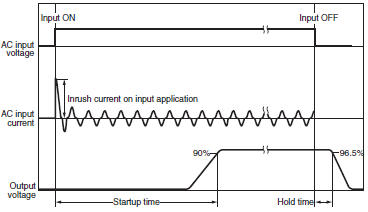
characteristics of fuses and operating characteristics of breakers making sure that the external fuses will not burn out
and the circuit breakers will not be activated by the inrush current.
Overload Protection
The product is automatically protected from short-circuit current and overcurrent damages when the load current is in the range of 151 to 175% of the rated current.
When the output current falls within the rated range, the overload protection function is automatically cleared.
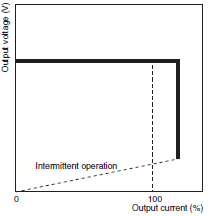
operation. Be sure to check that the Iout > 100% indicator is not lit or the Iout > 100% signal output is turned OFF
before using.
2. Internal parts may possibly deteriorate or be damaged if the Power Supply is used for applications with inrush
current or overloading at the load end. Do not use the Power Supply for such applications.
Overvoltage Protection
Overvoltage will be detected to prevent the load from being subjected to excessive voltage when the feedback circuit in the Power Supply fails, etc.
When an excessive voltage that is approximately 130% of the rated output voltage or more is output, the output voltage is cut OFF, preventing damage to the load due to overvoltage.
Reset the input power by turning it OFF for at least three minutes and then turning it back ON again.
Note: Do not turn ON the power again until the cause of the overvoltage has been removed.
INPUT OK Indicator
Note: The voltage may be applied even if the indicator does not light.
Be sure to check the input voltage when performing wiring.
DC OK Indicator/Signal Output
Note: 1. The output voltage may be generated even if the indicator does not light. Be sure to check the output voltage when
connecting to the load.
2. This function monitors the voltage at the power output terminals.
To check the voltage accurately, measure the voltage at the load end.
3. If the output voltage is set to less than 90% of the rated output voltage, the indicator may go off and the signal
output may be turned OFF.
Iout > 100% Indicator/Signal Output
Note: 1. The Iout > 100% Indicator may light up, and the Iout > 100% Signal Output may turn ON during peak current
operation, however, the Power Supply can be used as long as the operating conditions specified in Peak current
(Data Sheet) are satisfied.
2. Even when the operating conditions for parallel operation are satisfied, the Iout>100% Indicator / Signal Output
may operate, so do not use the Iout>100% Indicator / Signal Output.
3. During a short-circuit, the indicator will operate intermittently due to the overload protection function. When this
happens, the indicator will blink in accordance with the intermittent operation, and the Iout > 100% signal output
will repeated turn ON and OFF.
The shortest ON time of the Iout > 100% signal output during intermittent operation is 5 ms.
Specifications of the Signal Output Terminals (between DC OK Signal Output Terminal and COM Terminal, and between Iout > 100% Signal Output Terminal and COM Terminal)
30 VDC max., 50 mA max.
Residual voltage when the function is ON: 2 V max.
Leakage current when the function is OFF: 0.1 mA max.
Note: 1. Internal current control circuits are not provided internally for output signals. Do not allow the output current to
exceed 50 mA.
2. After completing wiring, confirm that the circuits operate correctly.
Identification of error locations at the input, product, and load side by the Indicator or Signal Output, and troubleshooting for the same (Maintenance point indicator)
Error locations at the input, product, and load side can be identified by the INPUT OK, DC OK, Iout > 100% Indicator / Signal Output.
Time chart (Operation of the Indicator/Signal Output according to the product status)
last update: December 1, 2023

